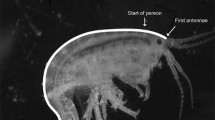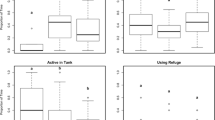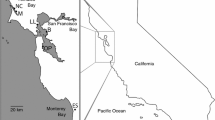Abstract
Within aquatic communities, individuals may gain survival benefits by responding to the chemical alarm signals of heterospecific prey guild members. Piscivorous individuals, however, should be selected to use such chemical signals as foraging cues. A variety of centrarchid species, such as largemouth bass (Micropterus salmoides), undergo an ontogenetic change in their response to the chemical alarm cues of heterospecific guild members, switching from antipredator to foraging responses. This ontogenetic shift should occur when potential foraging benefits outweigh any survival advantage gained from an antipredator response. To test this model, we exposed juvenile green sunfish (Lepomis cyanellus) to the skin extracts of conspecifics, a heterospecific prey guild member (finescale dace, Phoxinus neogeaus) or an allopatric heterospecific (green swordtails, Xiphophorus helleri). Juvenile sunfish exhibited a significant positive relationship between standard length and time spent moving and a significant negative relationship between length and time in a spine-erect posture, when exposed to dace skin extract, but not to either swordtail or conspecific skin extracts. Smaller individuals of less than 90 mm standard length (SL) decreased time moving and increased time with spines erect (indicating an antipredator response) while larger individuals (>90 mm SL) increased time moving and decreased time with spines erect (indicating a foraging response), when exposed to dace skin extract. Conversely, juvenile sunfish, regardless of size tested, always exhibited an antipredator response to conspecific skin extract. Sunfish exhibited no change in behaviour in response to swordtail skin extracts. These data further support our model of a threat sensitive trade-off in the response to chemical alarm signals by juvenile centrarchids.





Similar content being viewed by others

References
Brown GE, Brennan S (2000) Chemical alarm signals in juvenile green sunfish (Lepomis cyanellus, Centrarchidae). Copeia 2000:1079–1082
Brown GE, Chivers DP, Smith RJF (1995) Fathead minnows avoid conpsecific and heterospecific alarm pheromones in the faeces of northern pike. J Fish Biol 47:387–393
Brown GE, Adrian JC Jr, Smyth E, Leet H, Brennan S (2000) Ostariophysan alarm pheromones: laboratory and field tests of the functional significance of nitrogen oxides. J Chem Ecol 26:139–154
Brown GE, LeBlanc VJ, Porter LE (2001a) Ontogenetic changes in the response of largemouth bass (Micropterus salmoides, Centrarchidae, Perciformes) to heterospecific alarm pheromones. Ethology 107:401–414
Brown GE, Adrian JC Jr, Kaufman IH, Erickson JL, Gershaneck D (2001b) Responses to nitrogen-oxides by Characiforme fishes suggest evolutionary conservation in Ostariophysan alarm pheromones. In: Marchlewska-Koj A, Lepri JJ, Müller-Schwarze D (eds) Chemical signals in vertebrates 9. Kluwer, New York, pp 305–312
Brown GE, Gershaneck DL, Plata DL, Golub JL (2002) Ontogenetic changes in response to heterospecific alarm cues by juvenile largemouth bass are phenotypically plastic. Behaviour 139:913–927
Brown JA (1984) Parental care and the ontogeny of predator-avoidance in two species of centrarchid fish. Anim Behav 32:113–119
Chivers DP, Smith RJF (1998) Chemical alarm signalling in aquatic predator-prey systems: a review and prospectus. Écoscience 5:315–321
Chivers DP, Wisenden BD, Smith RJF (1995) The role of experience in the response of fathead minnows (Pimephales promelas) to skin extract of Iowa darters (Etheostoma exile). Behaviour 132:665–674
George CJ (1981) The fishes of the Adirondack Park. New York State Department of Environmental Conservation Special Publication, Albany, N.Y.
Helfman GS (1989) Threat-sensitive predator avoidance in damselfish-trumpetfish interactions. Behav Ecol Sociobiol 24:47–58
Keast A, Harker J, Turnbull D (1978) Nearshore fish habitat utilization and species associations in Lake Opinicon (Ontario, Canada). Environ Biol Fish 3:173–184
Lima SL, Bednekoff PA (1999) Temporal variation in danger drives antipredator behavor: the predation risk allocation hypothesis. Am Nat 153:649–659
Lima SL, Dill LM (1990) Behavioral decisions made under the risk of predation: a review and prospectus. Can J Zool 68:619–640
Mathis A, Smith RJF (1993) Chemical alarm signals increase the survival time of fathead minnows (Pimephales promelas) during encounters with northern pike (Esox lucius). Behav Ecol 4:260–265
Mathis A, Chivers DP, Smith RJF (1995) Chemical alarm signals: predator deterrents or predator attractants? Am Nat 146:994–1005
Mathis A, Chivers DP, Smith RJF (1996) Cultural transmission of predator recognition in fishes: intraspecific and interspecific learning. Anim Behav 51:185–201
Mirza RS, Chivers DP (2001a) Do chemical alarm signals enhance survival of aquatic vertebrates? An analysis of the current research paradigm. In: Marchlewska-Koj A, Lepri JJ, Müller-Schwarze D (eds) Chemical signals in vertebrates 9. Kluwer, New York, pp 19–26
Mirza RS, Chivers DP (2001b) Are chemical alarm cues conserved within salmonid fishes? J Chem Ecol 27:1641–1655
Mirza RS, Scott JJ, Chivers DP (2001) Differential responses of male and female swordtails to chemical alarm cues. J Fish Biol 59:716–728
Mittelbach GG, Persson L (1998) The ontogeny of piscivory and its ecological consequences. Can J Fish Aquat Sci 55:1454–1465
Nilsson PA, Brönmark C, Pettersson LB (1995) Benefits of a predator-induced morphology in crucian carp. Oecologia 104:291–296
Olson MH (1996) Ontogenetic niche shifts in largemouth bass: variability and consequences for first-year growth. Ecology 77:179–190
Olson MH, Mittelback GG, Osenberg CW (1995) Competition between predator and prey: resource-based mechanisms and implications for stage-structured dynamics. Ecology 76:1758–1771
Schutz F (1956) Vergleichende Untersuchungen uber die Schreckreaktion bie Fischen und deren Verbreitung. Z Vergl Physiol 38:84–135
Scott WB, Crossman EJ (1973) Freshwater fishes of Canada. Fish Res Bd Can Bull 184
Smith RJF (1997) Avoiding and deterring predators. In: Godin J-GJ (ed) Behavioural ecology of teleost fishes. Oxford University Press, Oxford, pp 163–190
Smith RJF (1999) What good is smelly stuff in the skin? Cross function and cross taxa effects in fish "alarm substances". In: Johnston RE, Müller-Schwarze D, Sorensen PW (eds) Advances in chemical signals in vertebrates. Kluwer/Plenum, New York, pp 475–487
Werner EE, Gilliam JF (1984) The ontogenetic niche and species interactions in size-structured populations. Annu Rev Ecol Syst 15:393–425
Werner EE, Hall DJ (1988) Ontogenetic habitat shifts in bluegill: the foraging rate-predation risk trade-off. Ecology 62:1352–1366
Acknowledgements
The authors thank James Grant and Antoine Leduc for comments on earlier versions of this manuscript, and Isabelle Désormeaux, Spence Gustav, Desiree Plata, and Josh White for assistance in the laboratory. Financial support was provided to G.E.B. by the Natural Science and Engineering Research Council of Canada, Concordia University and Union College. All work reported herein was conducted in accordance with Union College IACUC protocol number 2-27-98 and Concordia University Animal Care Committee protocol number AC-2002-BROW.
Author information
Authors and Affiliations
Corresponding author
Additional information
Communicated by A. Mathis
Rights and permissions
About this article
Cite this article
Golub, J.L., Brown, G.E. Are all signals the same? Ontogenetic change in the response to conspecific and heterospecific chemical alarm signals by juvenile green sunfish (Lepomis cyanellus). Behav Ecol Sociobiol 54, 113–118 (2003). https://doi.org/10.1007/s00265-003-0629-9
Received:
Revised:
Accepted:
Published:
Issue Date:
DOI: https://doi.org/10.1007/s00265-003-0629-9



